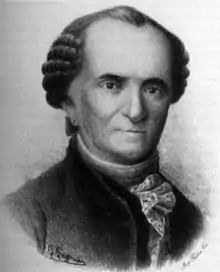Philibert Commerson
Philibert Commerson (French: [filibɛʁ kɔmɛʁsɔ̃]; 18 November 1727 – 14 March 1773),[1] sometimes spelled Commerçon by contemporaries, was a French naturalist, best known for accompanying Louis Antoine de Bougainville on his voyage of circumnavigation in 1766–1769.
Philibert Commerson | |
|---|---|
 Philibert Commerson | |
| Born | 18 November 1727 Châtillon-les-Dombes |
| Died | 14 March 1773 (aged 45) |
| Nationality | French |
| Scientific career | |
| Fields | |
| Institutions | Muséum national d'histoire naturelle |
Biography
Commerson was born at Châtillon-les-Dombes in France. He studied in Montpellier, and for a time was a practicing physician. He was in contact with Carl Linnaeus, who encouraged him to study fish of the Mediterranean.[2]:93
Commerson returned to live at Châtillon-les-Dombes, where he occupied himself in creating a botanical garden in 1758. After the death of his wife in 1764, he moved to Paris.[2]:93
In 1766, Commerson joined Bougainville on his voyage of circumnavigation after being recommended for the position of naturalist by the Paris Academy of Sciences. He had previously drawn up an extensive programme of nature studies for the Marine Ministry, in which he elaborated the "three natural kingdoms" which a naturalist should investigate on a voyage around the world.[3] Among the wildlife that Commerson observed was a particular kind of dolphin in the Strait of Magellan, now known as Commerson's dolphin (Cephalorhynchus commersonii).[4]
Commerson's partner and assistant, Jeanne Baré (also referred to Jeanne Baret), accompanied him on the voyage, disguised as a man. Baré acted as a nurse to Commerson, who was often ill, as well as assisting him in his scientific work. Her gender was only publicly discovered while the expedition was at Tahiti, but she remained with Commerson, nursing him and assisting him in his professional activities until the end of his life.[5]
Commerson was an astute observer of the Tahitian people and culture, thanks in part to a remarkable lack of European prejudice compared to other early visitors to the island. Commerson and Bougainville together were responsible for spreading the myth of Tahitians as the embodiment of the concept of the noble savage.[6]
Commerson also studied and collected plants wherever the expedition stopped; among others, he described the genus Bougainvillea.[7] On the return voyage to France in 1768, he remained behind at Mauritius (the then-French Isle de France), in order to botanize there and on Madagascar, an island that fascinated him. Pierre Sonnerat, who would also become a renowned botanist, was his personal secretary on the Isle de France.[8]
What admirable country Madagascar is! It would merit not a casual observer but entire academies. Madagascar, I may announce to naturalists, is their promised land; it is there that nature seems to have retreated as into a private sanctuary, to work on different models from any she has used elsewhere: The most curious, the most marvellous forms can be found at every step...
Death and legacy
Commerson died at Mauritius at the age of 45. His extensive collections from the voyage did not, unfortunately, receive their deserved recognition. Although his numerous manuscripts and herbaria were brought to Paris after his death they were never systematically organized and evaluated.[3] Unaware of his death in 1773, the Paris Academy of Sciences elected him as a fellow botanist just a few months later.[2]:93
References
- . Popular Science Monthly. 46. pp. 112–114. November 1894 – via Wikisource.
- Dorr, L.J. (1997). Plant Collectors in Madagascar and the Comoro Islands. Richmond, Surrey: Kew Publishing. ISBN 978-1900347181.
- Klaus-Georg Popp, in an epilog to Louis-Antoine de Bougainville, Reise um die Welt, Rütten & Loening Berlin 1977, pp 425f.
- Sharks and Whales (Carwardine et al. 2002), p. 370.
- Ridley, Glynis. "A Female Explorer Discovered On The High Seas". All Things Considered. National Public Radio (NPR). Retrieved 19 February 2012.
- Salmond, Anne (2010). Aphrodite's Island. Berkeley: University of California Press. pp. 116-117. ISBN 9780520261143.
- "Bougainvillea Comm. ex Juss". Tropicos. Missouri Botanical Garden.
- Morel, J.-P. (2002). "Philibert Commerson à Madagascar et à Bourbon" (PDF) (in French). Jean-Paul Morel. Archived from the original (PDF) on 6 June 2016. Retrieved 11 June 2016. Cite journal requires
|journal=(help) - IPNI. Comm.
See also
- French naturalists
- List of biologists